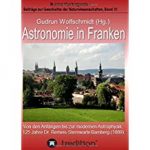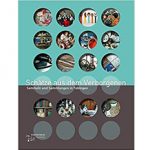Hier finden Sie einige meiner Publikationen zur Astronomiegeschichte und dem historischen Instrumentenbau. Die Beiträge sind größtenteils noch im Buchhandel erhältlich.
 |
Auf den Spuren historischer Sternwarten. Kost, Jürgen in: Wolfschmidt, Gudrun (Hg.): Proceedings der Tagung des AK Astronomiegeschichte in der Astronomischen Gesellschaft in Köln 2024, Hamburg: tredition (Nuncius Hamburgensis; Band 62) 2025, Der Band ist noch nicht erschienen! |
 |
The Castle Observatory in Tübingen – A Unique Ensemble. Kost, Jürgen. Reihe: Kleine Monographien des MUT, Ernst Seidl and Michael La Corte (Hg.), Band 10, Museum der Universität Tübingen MUT, 2020 (ISBN 978-3-9819182-6-7) |
 |
Die Tübinger Schloss-Sternwarte – Ein einzigartiges Ensemble. Kost, Jürgen. Reihe: Kleine Monographien des MUT, Ernst Seidl u. Frank Dürr (Hg.), Band 9, Museum der Universität Tübingen MUT, 2018 (ISBN 978-3-9819182-2-9) Vorwort: Spoiler
Wer sich auf die steile Burgsteige Richtung Schlosshof begibt, entdeckt kurz vor dem zweiten Schlossportal rechterhand ein kleines freistehendes Rundgebäude. Mit seinen grob bearbeiteten Sandsteinsegmenten erinnert es beim flüchtigen Betrachten an einen Brunnen. Sieht man sich das Gebäude mit dem Kegeldach und dem markanten Beobachtungsspalt aber etwas genauer an, so ahnt man vielleicht seine Funktion: es handelt sich um ein astronomisches Observatorium. Gebaut wurde es bereits im frühen 19. Jahrhundert unter der Direktion des Astronomen und Geodäten Johann Gottlieb Friedrich Bohnenberger (1765–1831). Zusammen mit dem im Innern der Kuppel erhaltenen Winkelmessinstrument von Utzschneider & Reichenbach ist dieses Ensemble weltweit einzigartig. Das kleine Observatorium war Teil der ersten Tübinger Sternwarte, die 1752 auf dem rund 40 Meter entfernten großen Nordostturm des Schlosses errichtet wurde. Dort gab es ebenfalls Beobachtungsmöglichkeiten, die aber seit dem Rückbau des Turmdaches in den 1950er Jahren verschwunden sind. Die Schloss-Sternwarte wurde über einen Zeitraum von rund 200 Jahren von verschiedenen Astronomen genutzt. Sie ist somit ein bedeutender Teil der über 500jährigen Astronomiegeschichte Tübingens. Einem Astronomen, Bohnenberger, war die Tübinger Sternwarte ganz besonders wichtig. Er legt den Nullpunkt der Württembergischen Landesvermessung in die Mitte des mächtigen Nordostturms des Schlosses.
|
 |
Fernrohre für jedermann – die Popularisierung der Astronomie durch Amateurteleskope. Kost, Jürgen in: Wolfschmidt, Gudrun (Hg.): Popularisierung der Astronomie, Proceedings der Tagung des AK Astronomiegeschichte in der Astronomischen Gesellschaft in Bochum 2016, Hamburg: tredition (Nuncius Hamburgensis; Band 41) 2017, S. 189-197 (ISBN-10: 3743918102) |
 |
The Merz Company: a Global Player of the 19th Century – by Jurgen Kost & Gudrun Wolfschmidt in: Ileana Chinnici (Hg.): Merz Telescopes, A heritage worth preserving. Springer-Verlag 2017 (ISBN: 3319414852) |
 |
Der Achteckturm der alten Tübinger Sternwarte. Kost, Jürgen in: Baumann, Eberhard (Hg.): Johann Gottlieb Friedrich Bohnenberger, Pionier des Industriezeitalters. Stuttgart: Kohlhammer 2015, S. 169-175 (ISBN: 3170289608) |
 |
Wissenschaftlicher Instrumentenbau der Firma Merz in München (1838-1932). Kost, Jürgen, Bearbeitet und herausgegeben von Gudrun Wolfschmidt. Hamburg: tredition (Nuncius Hamburgensis – Beiträge zur Geschichte der Naturwissenschaften, Band 40) 2015. (ISBN: 3732328856)
Rezension von Paolo Brenni:
Spoiler
Building the World’s Best Telescopes in BavariaWissenschaftlicher Instrumentenbau der Firma Merz in München (1838–1932). Jürgen Kost (Tredition, Hamburg, 2015). Pp. 620. € 54. ISBN 9783732328857.
This ponderous work by Jürgen Kost is the first detailed and modern history of the famous Bavarian instrument firm Merz, active for nearly a century and for several decades in the nineteenth century one of the most important makers of large refractors, astronomical objectives, and optical instruments. This book is divided into two parts. The first retraces the development of the firm, and illustrates the activities and role of its owners from Georg Merz to Paul Zschokke. The second part offers a detailed descriptive and illustrated list of about 90 large refractors and 100 large objective lenses made by Merz. An appendix presents a bibliography and various documents related to the activity of the firm. Kost begins with the intricate history of collaboration among Georg Reichenbach, Joseph Utzschneider, Joseph Liebherr, and Joseph von Fraunhofer and their Bavarian workshops. In 1819, Utzschneider and Fraunhofer were partners in their Munich optical institute; they produced their optical glass in Benediktbeuern. When Fraunhofer died in 1826 at the age of 39, Utzschneider had the difficult task of finding his successor. Despite a very short career, Fraunhofer had been the mastermind as well as the emblem of the workshop. He enjoyed international renown, and his instruments were considered among the best of his time. Furthermore, Fraunhofer knew the secrets of optical glass making, a technology he had developed and refined together with the Swiss glass maker Paul Guinand. After much hesitation, considering several possible candidates, Utzschneider finally chose Georg Merz, who had worked in the institute since 1808 as “first optician”, and Gustav Mahler, who had worked at the institute since 1820 as chief of the mechanics workshop. In 1829, Merz and Mahler successfully completed the Königsberger heliometer (aperture 16.2 cm), and in 1835 the Bogenhausen (München) refractors (aperture 28.3 cm). In 1839, Merz and Mahler became full owners. In the following years, they made some very important instruments, including the large refractor for the Pulkowa observatory (aperture 38 cm). Mahler died in 1845, and Merz became the sole owner of the institute. Georg’s youngest son Sigmund had began to work with him in 1842, and around 1845 the firm became G. Merz & Sohn. Sigmund’s brother Ludwig also collaborated with the firm, mostly as a representative for the business abroad, but his role in the company was less important than Sigmund’s. Between 1829 and the 1880s, the firm was a world leader in the construction of large telescopes and objectives, and equipped most of the important astronomical observatories of the time. On the other hand, their development of photographic objectives and cameras was not particularly successful. Georg died in 1867 and Sigmund owned the firm until 1883 when he retired and donated it to the sons of a younger brother of Georg. Meanwhile, competition from other European and American makers of large refractors (Grubb, Gautier, Clark, Warner and Swasey, Repsold, Steinheil, etc.) as well as from producers of optical glass (Feil, Chance, Schott) grew ever stronger, and thus, Merz lost the predominant market it had held for half a century. Finally in 1903, the instrument maker Paul Zschokke purchased the firm but retained the name G. & S. Merz. A particularly interesting instrument invented by L. Schupmann and developed and sold by Zschokke was the “medial-telescope.” Its objective was made of a single lens of crown, with correction made by two concavo-convex lens and a concave mirror set after the focus of the objective. Not requiring a large flint lens, the medial telescope gave a better correction of the secondary spectrum. Nevertheless, only a few instruments of this type were sold; the medial telescope never captured the favour of professional astronomers. With Zschokke’s death in 1932, the saga of the famous optical institute came to a definitive end. The second part of this book provides a 150-page inventory of the most important objectives, refractors, heliometers, comet seekers, and medial telescopes made by the firm. For each instrument, the maker’s precise name, customer’s name, dates of order and delivery, key technical data (aperture and focal length), and price, followed by brief descriptions of the instrument’s subsequent history, are listed. Many photos or engravings are included. Unfortunately, it is not always possible to understand whether an instrument is still extant. An appendix includes a bibliography, list of the firm’s catalogues published between 1811 and 1930, list of the glass smeltings completed at Benediktbeuern between 1842 and 1885, and facsimile reproduction of three Merz catalogues for 1832, 1878, and 1900. The bibliography is certainly ample, but the author appears to have focused on primary biographical sources and less on the secondary sources. This book was accepted as a doctoral dissertation at the University of Hamburg in 2014. Much of the existing literature on the history of nineteenth-century German instrumental optics focuses on achievements of Fraunhofer, who has become a kind of mythical father of modern optics. Certainly, his role in the development of this science, in optical glass and instrument making cannot be overestimated. Nevertheless, the premature death of Fraunhofer did not finish off the Munich optical institute. Kost clearly demonstrates how Georg Merz and his successors were able not only to continue Fraunhofer’s tradition of excellence but also to increase the range of their products and to become for several decades the world’s most important and appreciated maker of large telescopes and large objectives. This book thus casts a new light on the history of the Merz firm primarily by analysing, for the first time, correspondence and other archival documents related to the business and to the management of the company (see also Ivo Schneider’s richly documented book on Utzschneider, published in 2014). Kost’s volume will be an essential working tool and an invaluable source of information for historians of optics, optical instruments, instrumental astronomy, and precision industry in the nineteenth and early twentieth centuries. Paolo Brenni CNR, Fondazione Scienza e Tecnica p.brenni@museogalileo.it |
 |
Heliometer von Merz. Kost, Jürgen in: Wolfschmidt, Gudrun (Hg.): Astronomie in Franken, Von den Anfängen bis zur modernen Astrophysik 125 Jahre Dr. Remeis-Sternwarte Bamberg (1889). Hamburg: tredition (Nuncius Hamburgensis – Beiträge zur Geschichte der Naturwissenschaften; Band 31) 2015, S. 331-345 |
 |
Wissenschaftlicher Instrumentenbau der Firma Merz in München (1838-1932). Kost, Jürgen, Dissertation an der Universität Hamburg 2014, [Permalink] |
 |
Die Tübinger Barocksternwarte. Kost, Jürgen in: Wolfschmidt, Gudrun (Hg.): Der Himmel über Tübingen – Barocksternwarten – Landesvermessung – Astrophysik. Proceedings der Tagung des Arbeitskreises Astronomie-geschichte in der Astronomischen Gesellschaft 2013. Hamburg: tredition (Nuncius Hamburgensis; Band 28) 2014, S. 155-162 |
 |
Fernrohr in alle Welt – Die Geschäftsbücher der Firma Merz. Kost, Jürgen in: Wolfschmidt, Gudrun (Hg.): Sonne, Mond und Sterne – Meilensteine der Astronomie-geschichte. Zum 100jährigen Jubiläum der Hamburger Sternwarte in Bergedorf. Hamburg: tredition science (Nuncius Hamburgensis, Band 29) 2013, S. 97-103 |
 |
Die Äquatoreale der Firma Repsold in Hamburg. Kost, Jürgen in: Wolfschmidt, Gudrun (Hg.): Hamburgs Geschichte einmal anders – Entwicklung der Naturwissenschaften, Medizin und Technik, Teil 3. Hamburg: tredition science (Nuncius Hamburgensis – Beiträge zur Geschichte der Naturwissenschaften; Band 20) 2011, S. 62-77. |
 |
Tübinger Astronomie – Bohnenberger. Kost, Jürgen u. Müller Roland in: Seidl E., Aumann P., Dürr F.: Wunschbild und Weltverständnis. Tübingen: Universität Tübingen 2011, S. 69-99 [PDF] |
 |
Wissenschaftliche Instrumente. Kost, Jürgen in: Blattner, Evamarie und Wiegmann, Karlheinz (Hg.):Schätze aus dem Verborgenen. Sammler und Sammlungen in Tübingen. Tübingen: Universitätsstadt Tübingen 2010, S. 58-59 |
 |
J.G.F. Bohnenberger und seine Mechaniker. Kost, Jürgen u. Trierenberg, Andor in: DVW Mitteilungen, Hrsg. Landesverein Baden-Württemberg 57. Jahrgang (2010) Heft 2/2010, S. 60-69 |